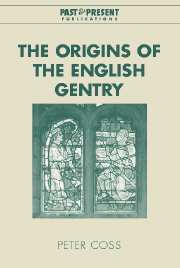Book contents
- Frontmatter
- Contents
- List of illustrations
- Preface
- 1 The formation of the English gentry
- 2 The roots of the English gentry
- 3 The Angevin legacy: knights as jurors and as agents of the state in the reign of Henry III
- 4 The crisis of the knightly class revisited
- 5 Knights in politics: minor landowners and the state in the reign of Henry III
- 6 Knighthood, justice and the early Edwardian polity
- 7 The explosion of commissions and its consequences
- 8 Identity and the gentry
- 9 Knights, esquires and the origins of social gradation in England
- 10 Crystallisation: the emergence of the gentry
- Appendices
- Bibliography
- Index
- Past and Present Publications
10 - Crystallisation: the emergence of the gentry
Published online by Cambridge University Press: 10 December 2009
- Frontmatter
- Contents
- List of illustrations
- Preface
- 1 The formation of the English gentry
- 2 The roots of the English gentry
- 3 The Angevin legacy: knights as jurors and as agents of the state in the reign of Henry III
- 4 The crisis of the knightly class revisited
- 5 Knights in politics: minor landowners and the state in the reign of Henry III
- 6 Knighthood, justice and the early Edwardian polity
- 7 The explosion of commissions and its consequences
- 8 Identity and the gentry
- 9 Knights, esquires and the origins of social gradation in England
- 10 Crystallisation: the emergence of the gentry
- Appendices
- Bibliography
- Index
- Past and Present Publications
Summary
The gentry finally crystallised during the first half of the fourteenth century. How should we account for this? Clearly, a full explanation has to encompass both social and institutional factors. I intend to approach the subject first by examining the structure of the gentry, and secondly by looking again at the characteristics of the gentry as outlined at the beginning of this study.
THE STRUCTURE OF THE GENTRY
When the gentry finally took shape towards the middle of the fourteenth century the county knights became its highest gradation. Their history has sometimes been written, however, as though they had occupied this position long before: as the highest grade in advance of gradation. On this reading the corpus of thirteenth-century knights was simply subdivided to form the fourteenth-century ranks. But this is to read history backwards. Moreover, it simplifies a complex evolution and it assumes a predetermined outcome. Among other things, it fails to account for the delay in the emergence of a second rank, the esquires. In fact, a sociologist observing the English nobility around the year 1300, and without the value of hindsight, could be forgiven for thinking that it was evolving along the same lines as the French noblesse, so intense was the sense of difference expressed by and around knighthood.
Nevertheless there were factors pulling this exclusive knighthood asunder. Most obviously, there was the existence of a higher nobility. The line of demarcation between higher and lower nobility had never been particularly clear.
- Type
- Chapter
- Information
- The Origins of the English Gentry , pp. 239 - 254Publisher: Cambridge University PressPrint publication year: 2003

